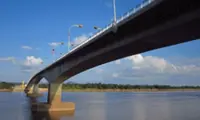- Photo: The Nation/ANN
BANGKOK: The Mekong River’s level at the Chiang Khan hydrological station in Loei province rose by another 68 centimetres reaching 16.29 metres on Friday (Sept 13) morning, which is 29cm above critical level.
The river, which borders Thailand and Laos, has broken its banks and flooded several villages in the three subdistricts of Loei’s Chiang Khan district, namely Bu Hom, Pak Tom, and Chiang Khan, provincial governor Chaipoj Charoonpong said.





